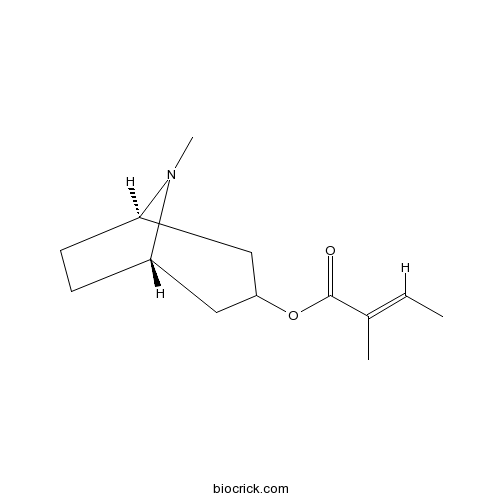TigloidineCAS# 533-08-4 |

- Tigloyltropeine
Catalog No.:BCN1944
CAS No.:495-83-0
Quality Control & MSDS
3D structure
Package In Stock
Number of papers citing our products

| Cas No. | 533-08-4 | SDF | Download SDF |
| PubChem ID | 12444363 | Appearance | Oil |
| Formula | C13H21NO2 | M.Wt | 223.31 |
| Type of Compound | Alkaloids | Storage | Desiccate at -20°C |
| Synonyms | tigloidin;Tropigline | ||
| Solubility | Soluble in Chloroform,Dichloromethane,Ethyl Acetate,DMSO,Acetone,etc. | ||
| Chemical Name | [(1S,5R)-8-methyl-8-azabicyclo[3.2.1]octan-3-yl] (E)-2-methylbut-2-enoate | ||
| SMILES | CC=C(C)C(=O)OC1CC2CCC(C1)N2C | ||
| Standard InChIKey | UVHGSMZRSVGWDJ-ZCFDAEMWSA-N | ||
| Standard InChI | InChI=1S/C13H21NO2/c1-4-9(2)13(15)16-12-7-10-5-6-11(8-12)14(10)3/h4,10-12H,5-8H2,1-3H3/b9-4+/t10-,11+,12? | ||
| General tips | For obtaining a higher solubility , please warm the tube at 37 ℃ and shake it in the ultrasonic bath for a while.Stock solution can be stored below -20℃ for several months. We recommend that you prepare and use the solution on the same day. However, if the test schedule requires, the stock solutions can be prepared in advance, and the stock solution must be sealed and stored below -20℃. In general, the stock solution can be kept for several months. Before use, we recommend that you leave the vial at room temperature for at least an hour before opening it. |
||
| About Packaging | 1. The packaging of the product may be reversed during transportation, cause the high purity compounds to adhere to the neck or cap of the vial.Take the vail out of its packaging and shake gently until the compounds fall to the bottom of the vial. 2. For liquid products, please centrifuge at 500xg to gather the liquid to the bottom of the vial. 3. Try to avoid loss or contamination during the experiment. |
||
| Shipping Condition | Packaging according to customer requirements(5mg, 10mg, 20mg and more). Ship via FedEx, DHL, UPS, EMS or other couriers with RT, or blue ice upon request. | ||
| Description | 1.Tigloidine hydrobromide, a naturally occuring analogue of atropine, could be as a substitute for atropine in the treatment of parkinsonism. |

Tigloidine Dilution Calculator

Tigloidine Molarity Calculator
| 1 mg | 5 mg | 10 mg | 20 mg | 25 mg | |
| 1 mM | 4.4781 mL | 22.3904 mL | 44.7808 mL | 89.5616 mL | 111.952 mL |
| 5 mM | 0.8956 mL | 4.4781 mL | 8.9562 mL | 17.9123 mL | 22.3904 mL |
| 10 mM | 0.4478 mL | 2.239 mL | 4.4781 mL | 8.9562 mL | 11.1952 mL |
| 50 mM | 0.0896 mL | 0.4478 mL | 0.8956 mL | 1.7912 mL | 2.239 mL |
| 100 mM | 0.0448 mL | 0.2239 mL | 0.4478 mL | 0.8956 mL | 1.1195 mL |
| * Note: If you are in the process of experiment, it's necessary to make the dilution ratios of the samples. The dilution data above is only for reference. Normally, it's can get a better solubility within lower of Concentrations. | |||||

Calcutta University

University of Minnesota

University of Maryland School of Medicine

University of Illinois at Chicago

The Ohio State University

University of Zurich

Harvard University

Colorado State University

Auburn University

Yale University

Worcester Polytechnic Institute

Washington State University

Stanford University

University of Leipzig

Universidade da Beira Interior

The Institute of Cancer Research

Heidelberg University

University of Amsterdam

University of Auckland

TsingHua University

The University of Michigan

Miami University

DRURY University

Jilin University

Fudan University

Wuhan University

Sun Yat-sen University

Universite de Paris

Deemed University

Auckland University

The University of Tokyo

Korea University
- Fmoc-Cys(Bzl)-OH
Catalog No.:BCC3475
CAS No.:53298-33-2
- CV 1808
Catalog No.:BCC7163
CAS No.:53296-10-9
- [Ala11,D-Leu15]-Orexin B
Catalog No.:BCC5877
CAS No.:532932-99-3
- Boc-Tyr(Me)-OH
Catalog No.:BCC3268
CAS No.:53267-93-9
- H-Sar-NH2.HCl
Catalog No.:BCC3333
CAS No.:5325-64-4
- 2''-O-Galloylhyperin
Catalog No.:BCN1218
CAS No.:53209-27-1
- Coixol
Catalog No.:BCN5703
CAS No.:532-91-2
- ar-Turmerone
Catalog No.:BCN7516
CAS No.:532-65-0
- Euparin
Catalog No.:BCN7191
CAS No.:532-48-9
- Tropinone
Catalog No.:BCN1935
CAS No.:532-24-1
- Anethole trithione
Catalog No.:BCN8510
CAS No.:532-11-6
- Methyocarbamol
Catalog No.:BCC3813
CAS No.:532-03-6
- Sesamol
Catalog No.:BCN2594
CAS No.:533-31-3
- 1,2,4-Benzenetriol
Catalog No.:BCC8409
CAS No.:533-73-3
- L-NMMA acetate
Catalog No.:BCC6788
CAS No.:53308-83-1
- Benzyl carbazate
Catalog No.:BCC8872
CAS No.:5331-43-1
- Isogosferol
Catalog No.:BCN5704
CAS No.:53319-52-1
- PP 3
Catalog No.:BCC7486
CAS No.:5334-30-5
- Z-Leu-OH.DCHA
Catalog No.:BCC2765
CAS No.:53363-87-4
- Boc-N-Me-Leu-OH
Catalog No.:BCC2616
CAS No.:53363-89-6
- trans,trans-Bis(4-fluorobenzal)acetone
Catalog No.:BCC9180
CAS No.:53369-00-9
- 1,3,5-Trihydroxy-4-prenylxanthone
Catalog No.:BCN5705
CAS No.:53377-61-0
- Isovitexin 2'-O-arabinoside
Catalog No.:BCN7826
CAS No.:53382-71-1
- Erteberel (LY500307)
Catalog No.:BCC4491
CAS No.:533884-09-2
Effect of tea making and boiling processes on the degradation of tropane alkaloids in tea and pasta samples contaminated with Solanaceae seeds and coca leaf.[Pubmed:30857698]
Food Chem. 2019 Jul 30;287:265-272.
In this study, the degradation of tropane alkaloids in pasta under boiling (100 degrees C during 10min) and tea making (100 degrees C and let cool 5min) conditions has been evaluated for the first time. Pasta and green tea were contaminated with Datura Stramonium and Brugmansia Arborea seeds (pasta and green tea), whereas coca leaf tea was directly analysed. The compounds were extracted using solid-liquid extraction coupled to a preconcentration stage (only for the cooking water), and the compounds were analysed by liquid chromatography coupled to mass spectrometry (Exactive-Orbitrap analyser). Degradation studies indicate that concentration of tropane alkaloids decreases, and it depends on the compound, observing the highest degradation for tropinone, tropane, cuscohygrine and tropine, as well as it was observed that compounds migrated to the aqueous phase during cooking step. Finally, post-targeted analysis was performed and other tropane alkaloids were found, as scopine, Tigloidine or convolvine, showing a similar behaviour under cooking conditions.


